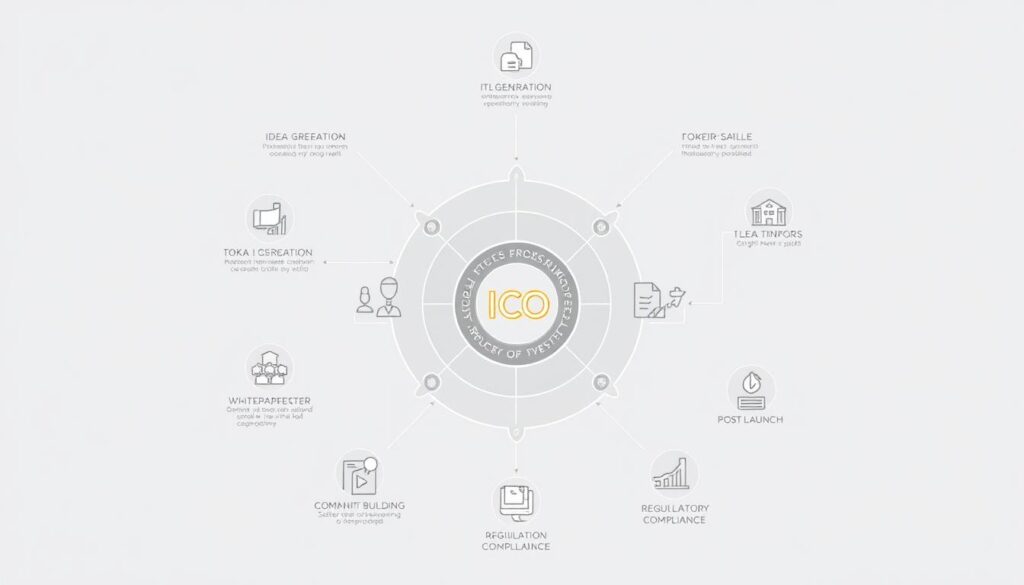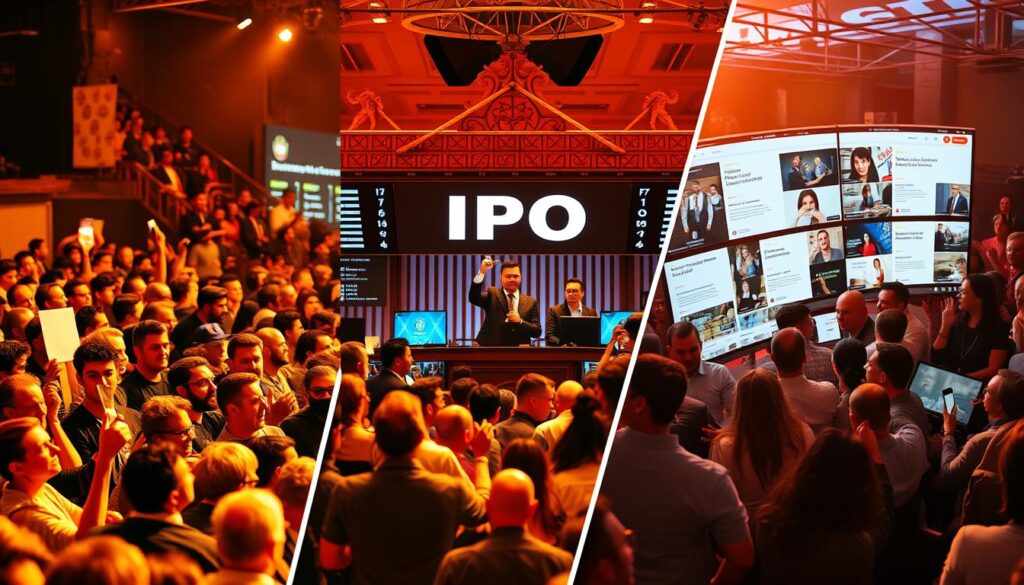Now Reading: Cryptocurrency ico initial coin offering: How it Works
- 01
Cryptocurrency ico initial coin offering: How it Works
Cryptocurrency ico initial coin offering: How it Works

The digital asset fundraising method known as an initial coin offering has transformed how new projects secure capital. This approach allows startups to bypass traditional funding routes and connect directly with global investors.
Unlike conventional public offerings that involve extensive regulations, this fundraising model operates with significantly less oversight. Companies can launch their own digital tokens and sell them to supporters during a specific fundraising period.
This method democratizes investment opportunities while introducing unique challenges. Potential backers must conduct thorough research before participating in any token sale. The landscape requires careful evaluation to navigate risks effectively.
Our guide provides essential information about how these fundraising events function. You’ll learn the mechanics behind successful digital asset launches and what factors to consider before investing.
Key Takeaways
- Digital token sales represent an alternative fundraising method for blockchain projects
- This approach bypasses traditional regulatory requirements faced by conventional offerings
- Startups can reach global investors directly through token distribution events
- Proper due diligence is essential before participating in any fundraising campaign
- The investment landscape combines innovation with significant risk factors
- Understanding the mechanics helps investors make informed decisions
- Comprehensive research separates promising projects from potential pitfalls
Understanding Cryptocurrency ico initial coin offering
Token distribution events offer startups an innovative path to secure development capital. This fundraising model allows ventures to create digital assets and exchange them for financial support.
Definition and Key Concepts
A company seeking capital typically outlines its vision in a detailed whitepaper. This document explains the project’s purpose, funding requirements, and token distribution plan.
Supporters purchase these digital tokens using various currencies during the campaign period. According to Investopedia’s comprehensive guide, these tokens function similarly to shares in traditional offerings.
There are two primary formats for these fundraising events. Private offerings target specific institutional investors, while public versions welcome broader participation.
Historical Context and Evolution
The Ethereum launch in 2014 marked a turning point for this fundraising method. The project raised $18 million over 42 days, demonstrating significant potential.
Subsequent campaigns like Dragon Coin’s $320 million raise and EOS’s record $4 billion offering showcased massive capital-raising capabilities. These events allowed blockchain ventures to access global investor pools without traditional geographic limitations.
Regulatory landscapes have evolved significantly since these early successes. Increased oversight has shaped how modern token sales operate today.
The ICO Process Explained
Companies planning token distributions must choose from multiple fundraising structures. Each model affects how investors participate and how the project manages its capital raise.

Structuring and Launching an ICO
Digital asset offerings typically follow three primary models. The static supply and static price approach sets fixed parameters from the start.
With static supply and dynamic pricing, the token quantity remains constant. The final price per unit depends on the total funds collected.
The dynamic supply model maintains a steady price per token. The total number issued adjusts based on investor demand.
| Model Type | Supply Flexibility | Price Stability | Best For |
|---|---|---|---|
| Static Supply/Static Price | Fixed | Fixed | Projects with clear funding goals |
| Static Supply/Dynamic Price | Fixed | Variable | Market-driven valuation |
| Dynamic Supply/Static Price | Variable | Fixed | Maximizing participation |
White Papers and Regulatory Considerations
Every legitimate project creates a detailed whitepaper. This document explains the venture’s purpose and funding needs.
Whitepapers must include specific technical and financial details. They outline token allocation, payment methods, and campaign duration.
Regulatory compliance is crucial for U.S.-based offerings. Rule 504 of Regulation D allows companies to raise up to $10 million annually with proper filing.
Projects must meet minimum funding thresholds to proceed. If targets aren’t achieved, funds typically return to supporters.
Evaluating ICOs: Investment Risks and Rewards
Evaluating digital fundraising campaigns involves balancing the appeal of innovation against the reality of regulatory uncertainty and fraud potential. Investors must approach each opportunity with careful scrutiny and realistic expectations.
Due Diligence and Authenticity Checks
Thorough research begins with verifying the project team’s credentials and track record. Look for transparent leadership with proven experience in blockchain technology.
Registered exchanges provide an additional credibility layer since they vet new listings. However, investors should conduct independent verification beyond platform listings.

Security Measures and Regulatory Oversight
Proper fund protection includes escrow wallets requiring multiple access keys. This security measure prevents single-point failures and protects investor money.
Regulatory bodies like the SEC have intervened in notable cases. The Telegram case resulted in $1.2 billion returned to investors after regulatory action.
| Risk Category | Common Examples | Impact Level | Mitigation Strategy |
|---|---|---|---|
| Team Verification | Anonymous developers | High | Background checks and track record analysis |
| Fund Security | Single-wallet access | Critical | Multi-signature escrow arrangements |
| Regulatory Compliance | SEC violations | High | Legal review and jurisdiction analysis |
| Celebrity Endorsements | Undisclosed payments | Medium-High | Verify disclosure compliance |
Celebrity promotions require extra caution, as seen in the Centra Tech case. Always verify that endorsements include proper disclosure statements.
While some investments generate substantial returns, many result in complete capital loss. Comprehensive due diligence remains the investor’s primary responsibility.
Comparing ICOs with IPOs and Crowdfunding
When comparing capital-raising methods, three distinct models emerge with unique characteristics and requirements. Each approach serves different business stages and investor expectations.
Core Differences in Fundraising
Traditional initial public offerings demand extensive regulatory compliance. Established companies must provide proven business records and stable financial history.
These public offerings involve lawyers, banks, and formal documentation. The process includes marketing roadshows and significant upfront investment.

Crowdfunding campaigns typically involve donations or product rewards. Supporters contribute without expecting financial returns.
Digital token sales combine elements of both approaches. They offer potential investment returns while operating with fewer formal requirements.
The U.S. applies the Howey Test to determine security status. This examines money investment, common enterprise, and profit expectations.
Timeframes differ significantly between these methods. Traditional offerings take months while digital sales can launch relatively quickly.
This accessibility democratizes funding for startups worldwide. Investors gain early access to emerging projects across borders.
Strategies for Successful ICO Investments
Investors seeking success in digital asset fundraising need a systematic approach to evaluation. Proper assessment separates promising opportunities from potential pitfalls.

Market Research and Tokenomics Analysis
Thorough market research examines industry trends and genuine demand. Investors should analyze the competitive landscape for similar solutions.
Token economics evaluation covers supply mechanisms and distribution models. Utility functions and vesting schedules reveal long-term value potential.
Scrutinize whitepapers for realistic projections and clear goals. Vague timelines or unexplained allocations signal red flags.
Promotion, Community Engagement, and Timing
Community quality often predicts project success. Authentic engagement beats artificially inflated metrics.
Early participation may offer discounts but carries higher risks. Balance timing against your risk tolerance.
Choose platforms that perform due diligence on listings. Reputable exchanges provide additional security layers.
Diversify across multiple investments rather than concentrating funds. This approach manages risk while seeking returns.
Conclusion
Navigating the world of digital asset fundraising requires careful balance between opportunity recognition and risk management. These token sales offer unique access to emerging blockchain ventures but demand thorough evaluation.
While successful initial coin offerings like Ethereum demonstrate the model’s potential, investors must remain vigilant against fraudulent offerings. Comprehensive research into each project‘s team, technology, and tokenomics remains essential.
The evolving regulatory landscape adds another layer of complexity. Investors should approach these opportunities as part of a diversified strategy, understanding that total loss remains possible.
This guide provides the foundational knowledge needed for informed participation. Continuous education and cautious optimism serve as the best approach to this dynamic investment space.
FAQ
What is the main purpose of a token sale?
A token sale is a fundraising method where a project sells digital assets to raise capital. It allows businesses to secure funds directly from a global pool of investors, bypassing traditional financial institutions.
How does an ICO differ from an IPO?
An initial public offering involves selling shares of a company on a regulated stock exchange. In contrast, an ICO typically offers utility tokens that provide access to a future service, often with less regulatory oversight.
What should I look for in a project’s white paper?
A strong white paper clearly explains the project’s technology, use case, team, and tokenomics. It should detail the development roadmap and provide transparent information about how raised money will be allocated.
Are these fundraising campaigns regulated?
Regulations vary significantly by country. In the United States, the SEC may classify certain tokens as securities, subjecting them to federal laws. It’s crucial to understand the legal landscape in both the project’s and investor’s jurisdictions.
What are the biggest risks for investors?
Major risks include project failure, fraudulent schemes, extreme market volatility, and potential regulatory actions. The lack of investor protection common in traditional markets makes thorough due diligence essential.
How can I verify the authenticity of a fundraising campaign?
Check the team’s credentials, review the project’s code on platforms like GitHub, analyze community engagement on Telegram or Discord, and look for reputable third-party audits of the smart contract and business plan.
What role does community play in a successful token launch?
A strong, engaged community can drive awareness, provide valuable feedback, and create network effects. Projects with active communities often have better long-term prospects and higher token value retention.
Can I participate in any token sale from any country?
No. Many projects restrict participation based on geographic location due to local regulations. Investors must often pass Know Your Customer (KYC) checks to comply with anti-money laundering laws.














